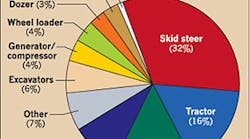With estimates of the total value of equipment stolen annually from construction and agricultural sites ranging between $300 million and $1 billion, there's no doubt that equipment theft is a serious problem in the United States. And where there's more equipment, there's usually more theft — as little as 10% of which is ever recovered. That's just one of the many messages revealed in the “2005 Equipment Theft Report” released in January from the National Equipment Register (NER), a database company located in New York established to reduce heavy-equipment theft rates and increase recoveries of stolen equipment.
Among the important trends highlighted in the report, NER found that only five states account for nearly 40% of the total number of thefts reported in the United States last year. Based on more than 5,000 theft reports submitted to NER in 2005, Texas leads all other states in the number of heavy-equipment thefts, followed by California, Florida, Missouri, and South Carolina.
The type of equipment most often stolen is linked to its mobility and value. For example, skid steers, tractors, and backhoes held the top three positions for most commonly stolen equipment in 2005. In fact, five types of equipment accounted for 78% of all losses (see chart).
“Not surprisingly, the availability and ease with which equipment can be stolen are the two factors that determine theft rates,” said David Shillingford, president and chief operating officer of NER. “A great deal needs to be done to improve equipment security as a deterrent against theft and to recover stolen equipment.”
Most equipment was stolen from non-owner premises because they typically have lower security. In fact, more than 70% of stolen equipment was taken from work sites in 2005 while less than 30% was stolen from insureds' premises, which are typically more secure, fenced storage facilities.
“This is because equipment spends more time on work sites than it does sitting idle on an owner's premises — and because work sites are generally harder to secure,” says Glen Sider, NEC operations manager.
NER offers a comprehensive outline of loss prevention and security techniques for equipment owners on its Web site at www.NERusa.com. However, a few of the highlights pertaining to vehicle security are particularly relevant here. Implementing the following suggestions from NER will help deter even the most determined thieves.
Equipment marking. Inventory management techniques, such as having each of your units registered on a national database used by law enforcement and bearing a decal warning thieves that this is the case, may make it less likely for your equipment to be stolen.
Anchoring and immobilizing. Given that a key may start more than one piece of equipment — and some equipment can easily be “hotwired” — consider using anchoring and immobilizing techniques to further safeguard your equipment. Equipment that must be left on-site should be anchored with either chain or cable. Large equipment can be immobilized by removing wires or battery and by lowering all blades or buckets. Consider installing theft prevention devices on higher risk or higher value equipment to disable fuel, hydraulic, and/or electrical systems. Portable equipment can be immobilized by removing tires if not being used regularly. This has the added advantage of protecting the tires.
Equipment in transit. Trailers and towables should use quality trailer hitch or king pin locks. Maintain minimum fuel levels on equipment being transported. This has both security and safety advantages. Secure and lock equipment to the transport platform. Neutralize the operating controls, and lock the ignition of the equipment being transported; make sure the keys for the unit being transported are not in the unit's ignition. If possible, remove the tongue off of the trailer. Plan transportation routes and schedules to avoid overnight stops wherever possible. If an overnight stop is unavoidable, try to find a temporary storage facility that is secure.
Equipment not in use. Ensure that all equipment is returned to its proper place, or an otherwise secure area, upon completion of a task or at the end of the day. Arrange/store equipment not in use in such a manner that a missing unit would be obvious, such as a single file row. Position larger pieces of equipment in a circular, wagon-train pattern, with generators, compressors and other small items inside the ring. Consider using lifting devices to secure smaller, more easily portable, items. Avoid leaving equipment on a trailer unattended. If this is unavoidable, consider unloading the unit and securing it to the trailer's hitch.



